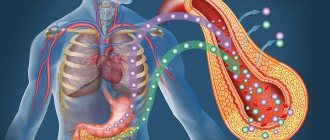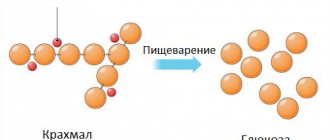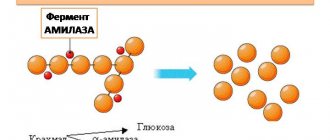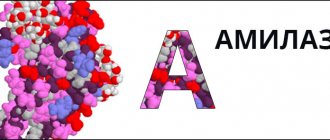Consequences
Pronounced upward changes in indicators will lead over time to damage to the pancreas, gastrointestinal tract, and liver.
A significant deterioration in the patient’s well-being will indicate a severe degree of organ deformation. To restore functional activity, medications for the liver and gastrointestinal tract based on PUFAs, essential phospholipids, pancreatin and other biologically active substances will be required. Sharply reduced levels will be accompanied by inadequate digestion of carbohydrates, insufficient levels of glucose in the blood plasma, and a deficiency of energy and calories.
Therefore, it is very important to find out the exact cause of low alpha amylase levels. Modern equipment in clinics makes it possible to objectively assess the functions of all body systems
An experienced doctor, based on the data obtained, will be able to determine the cause and prescribe the optimal treatment.
Functions
Food entering the body undergoes complex transformation processes before it can be absorbed by cells. Thus, carbohydrates cannot enter cells unchanged; during the digestion process, they are broken down to the level of simple substances.
To initiate the reaction of the breakdown of complex polysaccharides into simple components, the body produces special enzymes. One of them is amylase, which is a kind of catalyst for the reaction of converting starches into monosaccharides.
Where is it synthesized?
The enzyme amylase is produced in different organs. Some of this enzyme is produced in the salivary glands. Therefore, the process of carbohydrate absorption begins during chewing. However, in the stomach this process stops, since amylase is inactive in gastric juice.
The main process of carbohydrate processing occurs in the duodenum. Enzymes come here, including amylase, which are produced in the pancreas.
Advice! The activity of amylase produced by the pancreas is significantly higher than that of salivary amylase. This enzyme can decompose even starches that have not been subjected to heat treatment into simple components.
The enzyme is also produced in small quantities in other organs, in particular:
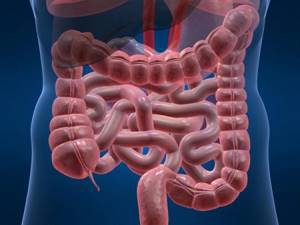
- in the intestines;
- in the liver;
- in adipose tissue;
- in the ovaries and fallopian tubes (in women).
Monosaccharides, which are formed as a result of the decomposition of carbohydrates, pass through the intestines and enter the portal vein, through which they enter the liver and the bloodstream, providing the body's cells with energy.
The amylase enzyme is partially neutralized by the liver and partially excreted by the kidneys. Therefore, to determine the content of this enzyme, a study is carried out not only in blood, but also in urine.

Changes in alpha amylase levels in children
Alpha amylase: normal, in blood, urine, increased, decreased
The pancreas in children, like other internal organs, does not function actively enough. Over the years, it matures and digestion normalizes. A provoking factor is the consumption of excessive amounts of sweets, carbonated drinks, a tendency to snack or long breaks between meals.
To prevent or get rid of existing disorders in the pancreas, you should follow your food intake, eliminate everything harmful and avoid snacking. The menu must include soups based on meat, vegetables and grains. Mayonnaise, ketchup and other sauces should be completely avoided, especially if negative pancreatic symptoms have already been noted.
Alpha amylase is elevated in the blood: the causes can be eliminated by following simple rules. In order to reduce the load on the child’s digestive tract, it is recommended to grind food to a puree using a blender or a special kitchen crush.
A small child should be fed with a teaspoon; older children should be reminded to chew their food thoroughly, moistening it generously with saliva. To normalize health, you should not overfeed your child. Small meals throughout the day will improve digestion and facilitate the functioning of internal organs. If you have problems with the pancreas, Creon capsules are well suited.
Their contents look like small balls. There will be no problems with swallowing. You should just immediately give the drug a small amount of water to drink, without allowing the child to bite into the granules.
Against the background of inflammation of the pancreas, eating is very difficult. Due to insufficient nutrition and hypersecretion of digestive enzymes, gastritis may develop or an exacerbation of an existing chronic form may occur. Bee honey is a very effective natural remedy.
To purchase a natural product, it is better to contact honest beekeepers. Among your acquaintances there will probably be someone who can give you the contacts of a reliable person. The only condition for the successful outcome of such therapy is to take it in small portions, alternating with tea or water.
Surgery is one of the causes of increased alpha amylase in the blood.
The main thing to remember is that honey does not tolerate heat. Therefore, you cannot mix it with hot tea. If this rule is not followed, harmful carcinogenic substances are formed, and all benefits disappear.
Values below the reference values indicate causes related to the defective functioning of the liver, thyroid or pancreas. In adolescents and young children, too low numbers indicate possible genetic pathologies such as cystic fibrosis, fermentopathy and others. Therefore, timely treatment is necessary for normal development in the future.
What is amylase?
Iodophilic flora in the feces of an adult: causes and treatment
Amylases (alpha-amylase) are a group of enzymes that serve to break down complex carbohydrates; Inside the pancreas, which is an exocrine gland, the enzyme is synthesized by acinar cells and then passes through the pancreatic ducts and reaches the digestive tract.
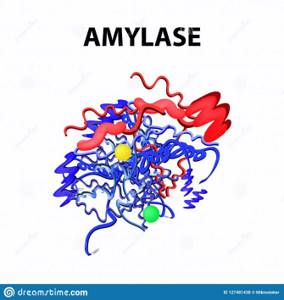
Amylases are also produced by the salivary glands, small intestinal mucosa, ovaries, placenta and liver. Pancreatic and salivary isoenzymes are detected in the blood at high concentrations by examination.
Under normal conditions, amylase is present in small amounts in the blood and urine, however, when the cells of the pancreas have some problem, such as pancreatitis or when the pancreas is blocked by a stone, or in rare cases by a tumor, the enzymes enter the blood circulation more easily, so their concentration increases as in blood and in urine (amylase leaves the body through urine).
Amylase testing is often used by doctors to diagnose pancreatitis. Pancreatic amylase testing (amylase P isoenzyme) is most useful for laboratory diagnosis of acute pancreatitis.
Total serum (blood) is still the most widely used method for diagnosing acute pancreatitis and is accurate to 95% (accuracy of a diagnostic test refers to its ability to provide true values).
The problem with this test, however, is the relatively low specificity, which is between 70 and 80% (the specificity of a diagnostic test is defined as the ability to correctly identify healthy people, i.e. those who are not affected by the disease or condition that is to be detected).
Amylase and its role in the body
Amylase (alpha-amylase) is an essential enzyme that is involved in digestive processes and ensures the breakdown of carbohydrates. With its help, nutrients entering the body break down into starches and polysaccharides, after which they are absorbed into the blood, supporting metabolism and vital processes. The production of the substance occurs in the pancreas and salivary glands, and an analysis to determine its content is prescribed if organ diseases are suspected. An increase in indicators may indicate dangerous disorders that require immediate medical attention.

What can affect the analysis results
Pancreatic amylase: increased and decreased levels

Drinking alcohol on the eve of the test is not recommended
If the situation is critical and the analysis is taken in a hospital, then the numbers obtained in the laboratory are considered true, regardless of what time the blood was donated, how long ago the person ate, etc.
If blood sampling occurs in a more relaxed mode and the result is in doubt, then this may be due to a violation of the recommendations for preparing for the test:
- perhaps the patient was taking some medications that he forgot about or did not want to notify the doctor;
- exercised intensively in the morning, before donating blood;
- maybe there was stress, a nervous breakdown, psycho-emotional instability;
- maybe the patient did not follow the recommended diet or drank alcohol.
In addition to factors depending on the patient, there may be errors made by the staff of the medical institution. For example:
- late delivery to the laboratory;
- delivery at high or low ambient temperatures without a special container.
Indicators of normal enzyme content
The degree of amylase enzymatic activity is measured by biochemical analyzes of plasma and urine. In the blood, enzymes are in a diluted state and the average value is considered to be about 60 - 80 units / l, depending on age. And it accumulates in urine in a more saturated form, so the norm is about 600 - 800 units/l in a daily analysis.
Blood amylase levels
The level in plasma depends on the age of the person; gender does not matter.
| Age | Normal value, units/l | Maximum value, units/l |
| Up to 1 year | 5 – 60 | 60 – 65 |
| From 1 year to 50 years | 20 – 100 | 100 – 110 |
| From 50 to 60 years | 30 – 130 | 130 – 140 |
| From 60 years and older | 20 – 160 | 160 – 170 |
If the patient’s indicators are higher than the maximum value, then this is considered a pathology. For a more accurate result, the test is taken in the morning before eating.
Amylase levels in urine
Urine tests to determine the level of diastase are carried out more often than blood plasma analysis, due to its greater information content. In case of serious illnesses, the presence of this enzyme in urine persists longer than in plasma.
| Age | Normal diastase indicator in urine |
| children under 16 years old | 15 - 65 units/liter |
| from 16 to 55 years old | From 10 to 125 units/liter |
| over 55 years old | 26 – 159 units/liter |
In adult men and women, the amount of diastase does not differ significantly; only the patient’s age is taken into account. This indicator is absent in newborns.
Additionally
Elevated enzyme values in the results of biochemical examination are determined much more often than low values. A high concentration of α-amylase indicates possible diseases:
- pancreatitis and pancreatic cancer;
- intestinal obstruction;
- diabetes mellitus and diabetic ketoacidosis;
- peptic ulcer of the duodenum and stomach;
- ectopic pregnancy;
- cholelithiasis and urolithiasis;
- CRF, chronic renal failure;
- alcoholism;
- parasitic infestations;
- mumps (mumps);
- appendicitis.
If the test results deviate from the norm, the patient requires additional examination.
Memo to patients
Proper preparation is the guarantee that the result will be correct. In laboratories, the morning or daily portion of biological fluid is examined. In the first case, the following rules should be followed:
- The optimal time period is from 6 to 10 am. If the collection is performed on a child in the first year of life, it is convenient to use special devices. They are a transparent soft but dense container. It is necessary to attach it to the outer part of the penis (for boys, the penis should be tucked inside) using the adhesive area. The collection does not cause any inconvenience to the baby. Removing the container is easy.
- 12 hours before collection, salty and spicy foods should be excluded from the diet. This rule applies more to adults.
- One day before the delivery date, it is not allowed to consume alcoholic beverages, baked goods, or medications.
- Genital hygiene is necessary.
- The first portion of urine must be drained, since it may contain mucus that has accumulated overnight.
For analysis, 50 ml of biological material is sufficient.
The daily dose is taken according to similar rules. Each sample is collected in a separate container, onto which a sticker is affixed indicating the exact time of collection. It is also recommended to keep a food diary.
About the analysis
Determining the level of amylase enzyme in the blood is most often necessary for diagnosing diseases of the digestive system. The rate of enzyme production depends on the time of day; enzymes are produced more actively during the day than at night.
Advice! Since amylase is not produced in sufficient quantities at night, the habit of frequently snacking at night can cause digestive disorders.
There are two types of alpha-amylase in the blood:
- S-type, produced by the salivary glands, its share is about 60% of the total amount of the enzyme;
- P-type, synthesized by the pancreas.
Determining the level of the enzyme in urine and blood serum is of diagnostic importance. Often, it is enough to determine the level of total amylase, but sometimes it is necessary to determine the concentration of the P-type enzyme.
How is it going?
Basic rules for carrying out procedures:
- the patient must give blood samples in the morning on an empty stomach;
- if there is a suspicion of an acute form of pancreatitis, then the analysis is carried out at any time of the day, since it is impossible to leave the patient in such a serious condition until the morning;

- The last meal should take place no earlier than 12 hours before the procedure. During the day you need to eliminate alcohol and excessively fatty foods;
- the samples taken are immediately sent to the laboratory, the study must be carried out within an hour after collecting the material;
Advice! If conditions do not allow analysis immediately after sampling, then the collected material is frozen and stored at sub-zero temperatures until delivered to the laboratory.
Norms
The level of amylase in the blood can be expressed in different units of measurement. Therefore, you should always pay attention to the laboratory form, which indicates not only the obtained values, but also the accepted standards.
Most laboratories perform analysis with results expressed in units/l. For children over two years of age and adults under 70 years of age, the normal range is from 20 to 120. For people over 70 years of age, the norm may be slightly higher.
If amylase is elevated, what does this mean?
A gradual increase in the level of amylase in the blood occurs within several hours from the onset of an attack of acute pancreatitis. After the attack ends, this indicator returns to normal, but this takes several days. Acute pancreatitis can cause amylase levels to be 5 or 6 times higher than normal. However, if amylase is elevated, this does not always indicate pancreatitis; moreover, sometimes even during an attack and after it, amylase may remain within normal limits. Therefore, to make an accurate diagnosis, it is necessary to take into account other markers, for example, lipase levels.
Other diseases that can cause elevated blood amylase levels:
- pancreatic cyst,
- malignant tumor of the pancreas,
- diseases of the biliary tract and gallbladder,
- chronic renal failure,
- inflammatory processes in other abdominal organs,
- cystic fibrosis,
- alcohol intoxication,
- ectopic pregnancy,
- diabetes,
- parotitis,
- insufficient activity of the salivary glands, for example, when they are damaged.
Taking certain medications can have a similar effect. Therefore, before taking a blood or urine test to check your amylase level, be sure to tell your doctor about all the medications you have taken recently. Including hormones and oral contraceptives.
Reasons for low performance
Low amylase levels are not abnormal in young children. Due to the characteristics of the baby’s diet and digestive system, a small amount of pancreatic enzyme is sufficient. The main part of amylase is found in the baby's salivary glands, helping him to fully absorb breast milk.
The activity of amylase and other digestive enzymes may be reduced in children due to the severe congenital pathology of muscovidesis. The disease is characterized by dysfunction of the exocrine glands and the functioning of the digestive and respiratory organs. The cause of the disease is the inheritance of damaged genes from both parents (autosomal recessive inheritance). Infants in the first year of life with this diagnosis have an extremely unfavorable prognosis.
A pathological abnormality associated with enzyme deficiency is fermentopathy. The disease may be congenital or acquired. In the first case, the decisive factor in the occurrence of digestive abnormalities is a genetic cause. In the second, stable eating disorders or chronic pathologies of the gastrointestinal tract (gastrointestinal tract).
Other reasons for decreased alpha-amylase concentrations are associated with diseases of the hepatobiliary system:
- Irreversible transformation of hepatocytes (liver cells) into connective tissue – cirrhosis. By nature of origin it can be viral, alcoholic, metabolic and nutritional.
- Chronic inflammatory liver damage - hepatitis. The chronic form develops as a result of incorrect therapy or patient violation of the rules for treating viral hepatitis A, B, C.
Deviations in the analysis parameters are observed in case of mechanical damage (tissue rupture, blood vessels, bruises, wounds, etc.) of the digestive system. The level of alpha-amylase in this case can be either lower than normal or higher. Reduced enzyme activity is recorded in the postoperative period in patients who have undergone surgery on the abdominal organs.
The most common reason is partial resection or complete removal of the pancreas (pancreatectomy). Another cause of enzyme deficiency is extreme pancreatitis, characterized by the death of pancreatic cells - pancreatic necrosis. The degeneration of cells and tissues of the body, with the loss of the ability to produce biologically active substances, accompanies cancer. In severe stages of cancer, the synthesis of enzymes, hormones, etc. decreases or completely stops.
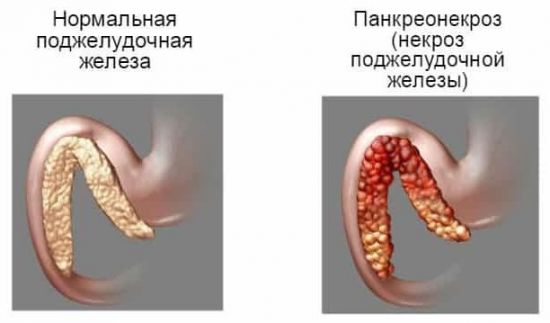
The only treatment for pancreatic necrosis is pancreatic necrectomy
A rare pathology in which the concentration of amylase is disrupted is benign macroamylasemia (an abnormal combination of enzyme molecules with other blood molecules). A low level of α-amylase in the blood of women during pregnancy characterizes toxicosis of pregnant women.
With insufficient production of alpha-amylase, overactivity of the thyroid gland often occurs - hyperthyroidism or excess production of hormones. Regardless of the reason, a lack of an enzyme inhibits the full functioning of the digestive organs. The body is not able to properly process and absorb nutrients (fats, proteins, carbohydrates). Metabolism is disrupted, diseases of the gastrointestinal tract and endocrine system progress.
Amylase in the blood
Amylase (other names: alpha-amylase, diastase, pancreatic amylase) is a biologically active substance involved in the metabolism of carbohydrates. In the human body, most of it is produced by the pancreas, and a smaller part by the salivary glands.
The human body synthesizes only alpha-amylase, which is a digestive enzyme.
Indications for analysis
Despite the fact that blood amylase reflects changes characteristic of many metabolic and inflammatory diseases (diabetes mellitus, hepatitis, mumps and others), the main indication for analysis is a suspicion of acute or chronic pancreatitis.
To determine the level of blood amylase, a biochemical test of blood from a vein is used. Blood is drawn in the morning on an empty stomach (the day before the test, you should avoid eating spicy and fatty foods).
Blood amylase level
Since the pancreas is a mixed secretion gland (it secretes hormones and enzymes both into the intestinal lumen and into the blood), the amylase produced in it is usually distinguished from general alpha-amylase and called pancreatic amylase. Accordingly, in a biochemical blood test (or urine, which is also used to determine the level of amylase in the body), two indicators of amylase are distinguished: alpha-amylase and pancreatic amylase.
Alpha amylase
For alpha-amylase (representing the total amount of all amylase in the body), the following values are considered normal: *
- children under 2 years old: 5 - 65 U/l;
- 2 years – 70 years: 25 – 125 U/l;
- over 70 years old: 20 - 160 U/l.
- *according to independent laboratory Invitro
- Pancreatic amylase
- Alpha-amylase includes pancreatic amylase, the amount of which is also measured. The normal amount of pancreatic amylase is considered*:
- children under 6 months:
- children 6 - 12 months:
- all over 1 year:
*according to independent laboratory Invitro
Reasons for deviations from the norm
Reasons that cause an increase in the amount of alpha-amylase in the blood (increased blood amylase is considered to be figures above 105 units/l for alpha-amylase and above 50 units/l for pancreatic amylase):
- Acute or chronic pancreatitis. With inflammation of the pancreas, the secretion of amylase by cells increases several times
- A cyst, tumor or stone in the lumen of the pancreas. A change in the structure of the gland causes compression of the glandular tissue and its secondary inflammation, which increases the secretion of amylase (amylase level reaches 150-200 units/l).
- Parotitis. Inflammation of the salivary glands also causes increased secretion of amylase (.
- Peritonitis. With peritonitis, all organs of the abdominal cavity, including the pancreas, are subject to irritation and inflammatory changes. Such changes increase the activity of pancreatic cells, which leads to increased amylase levels in the blood test.
- Diabetes. Diabetes mellitus causes systemic metabolic disorders, including carbohydrate metabolism. Thus, not all amylase produced by the body will be rationally spent on converting starch into oligosaccharides, which will lead to an increase in its amount in the blood.
- Kidney failure. Since amylase is excreted from the body through the kidneys, insufficient kidney function will cause a delay and increase in the amount of enzyme in the blood.
Reasons for a decrease in the amount of amylase in the blood (a decrease in the level of blood amylase is considered to be less than 100 units/l for alpha-amylase):
- Hepatitis in acute or chronic form. With hepatitis, carbohydrate metabolism is disrupted, which entails an increased load on the body's enzymatic systems, including amylase. For a certain time, the pancreas produces a sufficient amount of the enzyme, but subsequently begins to slow down the process of amylase synthesis, which will be reflected in its low amount in a blood test.
- Pancreatic tumors. Some tumors cause degeneration of pancreatic tissue, which makes amylase secretion impossible.
Also, as a result of injuries, falls from a height and poisoning, amylase secretion may be impaired, either to a greater or lesser extent.
Functions of amylase
The function of amylase is to break down starch into simpler forms - oligosaccharides. The breakdown begins in the oral cavity, since amylase is part of saliva, and then in the gastrointestinal tract, where most of it is synthesized by the pancreas.
Since starch molecules, due to the complexity of their structure, cannot be absorbed in the intestinal loops, the quality of absorption of food carbohydrates depends on the action of amylase.
Reasons for increased amylase
When detecting blood amylase levels, the norm in adults depends on the reference values of a particular laboratory, and is usually up to 31 U/L in women and up to 41 U/L in men.

An increase in numbers by a factor of two or more is considered a dangerous sign - it means that the human digestive system is working abnormally, which can lead to serious consequences.
A slight increase in amylase concentration may be transient and not indicate serious disorders.
If the enzyme content is elevated, it means that the pancreas is working too actively, secreting substances that immediately enter the blood. This becomes possible for a number of reasons:
- excess production of pancreatic juice - a special liquid that is produced in the pancreas and is actively involved in the digestive processes;
- obstacles appear that interfere with the movement of juice through the ducts of the organ;
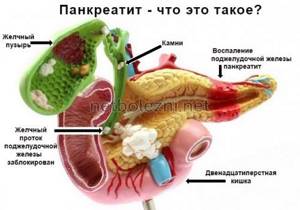
- Inflammatory processes occur in the tissues of the pancreas or neighboring organs - consequences of tissue destruction, the action of pathogenic microorganisms, necrosis, and mechanical injuries.
Each of the above conditions can pose a threat to human health or even life, and in some cases requires immediate medical attention.
Most common diseases
There are a number of diseases in which patients most often experience an increase in amylase concentration.
Endoscopic examinations of the intestines are considered the most informative and safe diagnostic procedures. These include sigmoidoscopy - a study that is carried out to identify diseases of the lower gastrointestinal tract. Read more in the article: “sigmoidoscopy of the rectum.”
| Disease | Features and symptoms |
| Acute pancreatitis | Inflammation that develops in the tissues of the pancreas with lightning speed. The organ begins to work in increased mode, as a result of which tissue is damaged by its own enzymes. Signs: severe girdle pain, uncontrollable vomiting, bloating, flatulence |
| Chronic pancreatitis | In the chronic course of the disease, changes in tissues occur gradually, often without pronounced symptoms. The first signs of the condition are discomfort that occurs after eating - heaviness and nagging pain in the right hypochondrium, belching, hiccups, changes in appetite |
| Neoplasms in different parts of the organ | Most often, benign and malignant tumors are localized in the head of the pancreas, but they can also affect other parts of it. Manifestations of cancer depend on the characteristics and size of the tumor, include digestive disorders, pain of varying intensity, anemia and constant weakness |
| Cholelithiasis | During a pathological process, stones form in the gallbladder and its ducts, which obstruct the movement of bile. The first symptoms are pain and discomfort on the right side under the ribs, a feeling of bitterness in the mouth, heartburn, fever, discoloration of stool |
| Diabetes | A systemic metabolic disorder that leads to disorders of almost all organs and systems, including the digestive system. Amylase and other enzymes in the patient's body are consumed incorrectly, which leads to an increase in their concentration. Signs include constant thirst, loss of appetite, sweating, decreased urine output, yellowing of the skin |
| Peritonitis | Inflammatory processes in the tissues of the peritoneum, which cause a serious condition requiring immediate surgical intervention. With peritonitis, the pancreas is irritated, which increases its activity. It usually manifests itself acutely, with severe abdominal pain, nausea and vomiting, fever, loss of consciousness |
| Mumps | A disease common in children and known as mumps or mumps. It is caused by pathogenic microorganisms, and its manifestations include enlargement of the salivary glands, which are also involved in the production of amylase. Symptoms of mumps resemble a common cold; characteristic swelling appears near the child’s ears, which is considered a specific sign of the disease |
| Kidney failure | A pathological condition of the urinary system, which is characterized by impaired renal function - they cannot produce and excrete urine in a timely manner. Unlike other diseases, with renal failure there is not an increase in amylase production, but its retention in the body |
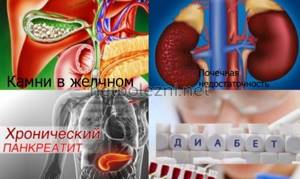
A short-term increase in amylase in the absence of accompanying symptoms may not indicate disorders in the body. In such cases, the level of the enzyme is determined dynamically - if amylase is elevated in an adult, this means that he requires a more accurate comprehensive study.
Other reasons
Other reasons that can cause an increase in amylase concentration in the blood include:
- mechanical injuries of the abdominal cavity;
- aneurysms;

- tumor processes of the genitourinary system;
- taking medications;
- gallbladder pathology;
- frequent stress and psycho-emotional tension;
- intestinal obstruction;
- herpes virus in the body;
- postoperative conditions (abdominal surgery).

Sometimes an increase in amylase levels is observed during nutritional disorders - the predominance of fatty, smoked, salty and pickled foods,
What happens when amylase levels rise?
For a middle-aged adult, alpha-amylase levels up to 120 units/l and pancreatic amylase levels up to 50 units/l are considered normal. A slight excess of these parameters is a temporary phenomenon, can be associated with eating foods rich in carbohydrates, emotional or physical stress and should not cause a noticeable deterioration in well-being.
Pathology is indicated when the amount of enzyme increases greatly and is accompanied by the following symptoms:
- pain in the right side, intensifying after eating;
- diarrhea;
- deterioration of health, weakness, fatigue.
Amylase indicators
Expert opinion Cardiologist Grigory Viktorovich
In the blood of females and males, the indicator remains unchanged. A woman’s body is able to withstand pathologies in the pancreas; they are more resistant than men.
The dependence on a specific age category can be traced by the following indicators:
- a baby under 1 year old has an average of up to 8 units/l;
- a child under 10 years of age has up to 30 units/l;
- up to 18 years of age, a child has an average rate of up to 40 units/l;
- an indicator of up to 125 units/l is observed in people under 70 years of age;
- up to 160 units/l is the norm for people over 70 years of age.
Some amylase is excreted in the urine. Its presence in this component is called “diastasis”. The determination of the indicator value occurs in parallel with lipase in the blood.
Possible types of research:
- General analysis of alpha amylase;
- Pancreatic amylases are used.
- Urine diastasis is determined.
Attention! A slight deviation from the norm is considered insignificant. Especially if no additional alarming symptoms were noticed
An error of this kind can cause the human body to experience a stressful situation.
What amylase level values are considered low, normal?
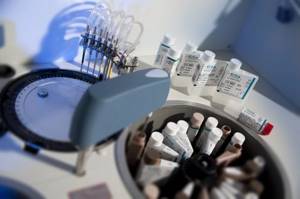
Each laboratory has its own reference values for the indicator
It should be taken into account that in various laboratories the study is carried out on biochemical analyzers from different medical companies. Standards may be in different units of measurement and therefore differ from each other. As a rule, reference values and some kind of flag indicating a decrease or increase relative to them are placed next to the result. The most commonly used measurement is Units of substance per 1 ml of blood.
In a healthy adult, the level of alpha-amylase in the blood is from 28 to 100 U/l,
in children under two years old 5 - 65 U/l,
in elderly people over 70 years old 30-160 U/l
Of these, pancreatic amylase in adults and elderly 0-50 U/l
In children under six months of age up to 8 U/l
From six months to a year no more than 23 U/l
From one to two years not higher than 50 U/l
Amylase is considered low if it is below 25 U/L for an adult. For children, according to age and table of norms.
What if the level is elevated?
A slight increase is acceptable if the person’s condition and well-being are not impaired. This may be due to emotional stress, heavy physical activity, and eating large amounts of carbohydrates.
A pathological increase in indicators occurs for the following reasons:
- excessive secretion of pancreatic juice;
- obstruction of circulation (strictures, stones, tumor);
- inflammation of the gland itself;
- viral or epidemic parotitis;
- peritonitis;
- ectopic pregnancy.
These problems do not appear on their own. As a rule, this is a consequence of infectious processes and pathological disorders of the gastrointestinal tract. When the indicators go off scale, the general condition of a person worsens. Weakness and fatigue appear. Possible pain in the right side, nausea, vomiting, diarrhea.
What to do if pancreatic amylase is elevated
A significant increase in pancreatic amylase in the blood is an indication for hospitalization.
Prehospital measures are aimed at eliminating pain and suppressing the activity of pancreatic enzymes.
Painkillers: Baralgin, Analgin, Tramal.
To eliminate spasm: Papaverine, Halidor, No-Shpa.
Antispasmodic anticholinergics: Buscopan, Metacin.
Normalization of sphincter of Oddi tone: Duspatalin.
Inhibition of the activity of pancreatic enzymes: Kvamatel (famotidine).
Antihistamines, antiserotonin drugs that reduce edema: Tavegil, Suprastin, Dimedro, Peritol.
In severe forms of acute pancreatitis, measures are taken in the intensive care unit. To reduce enzymatic toxemia, Contrical or other proteolysis inhibitors are administered intravenously on the first day of the disease. Antibacterial therapy is prescribed.
After the acute situation subsides, pancreatic enzymes that do not contain bile are prescribed in an intermittent course for up to 3 months (2 weeks on, 10 days off): Pancreatin, Mezim-Forte, Creon, Pancitrate (1 tablet 3 times a day with meals) .
Diet to reduce pancreatic amylase
In the first 1-2-3 days of an acute condition - hunger.
Then the following is gradually introduced into the diet: - mashed porridge with water; - slimy pureed soups with water; - milk; - weak tea with crackers; - omelette; - cottage cheese; - low-mineralized water without gas, 50-100 ml 5-6 times a day: Slavyanovskaya, Essentuki No. 4, Borjomi, Naftusya.
From the 7th day the following is allowed: - vegetable and potato purees; — steam cutlets, boiled fish; - White bread; - baked apples, fruit purees.
During the recovery period, herbal medicine can be used (after consultation with the doctor).
Herbal mixture for pancreatitis Goose cinquefoil - 1 tablespoon Celandine - 1 tbsp. l. Calendula - 1 tbsp. l. Marshmallow root - 1 tbsp. l.
Brew 1 tablespoon of the mixture with 1 glass of boiling water, heat in a water bath for 15 minutes. Sue. Take 1/3 cup 3 times a day 15 minutes before meals. Reception course: 1 month.
Diet No. 5P for elevated amylase and pancreatitis
Basic principles of nutrition:
- Avoid alcohol completely.
- Steam or boil food, chop it.
- Meal regimen: small portions, 4-6 times a day.
What is prohibited? Rich broths: meat, chicken, fish, vegetables, especially mushrooms. Hard-boiled eggs, fried eggs. Fatty meats, poultry, fish, game. Pork lard, beef and lamb fat. Raw: cabbage, radish, radish, sorrel, spinach, green onions. Smoked meats, spices, savory snacks, canned food, mushrooms, sausages. Baked goods, fresh baked goods, brown bread, ice cream, fatty desserts, cocoa, chocolate. Alcohol in any form.
What to limit? Fats: butter - 30 g, vegetable oil - 20 g per day. Fast carbohydrates, sugar. Coarse fiber, boiled (stewed) cabbage. Too sour, sweet raw fruits. Baked goods, confectionery, coffee, strong tea.
What is allowed? Dried white bread. Boiled, stewed vegetables. Any porridge, pasta. Lean meat, poultry, fish (steam cutlets, meatballs, soufflé, rolls, etc.) Eggs in the form of a protein omelet. Soft-boiled 1 piece per day. Milk, low-sour cottage cheese, Dutch and Adyghe cheese. Baked apples, fruit puree. Rosehip decoction, weak tea, jelly and compotes with xylitol.
The therapeutic diet is followed for at least 6 months. In the future, you should adhere to diet No. 5 according to Pevzner (watch the video).
Increased amylase levels in the blood and what it means
If amylase in the blood is elevated, then this is a rather alarming indicator, as it may indicate the following:
- Inflammation of pancreatic tissue in acute form.
- Chronic form of pancreatitis. Usually, with this type of disease, the enzyme level increases slightly or moderately, and with proper treatment and diet, it can return to normal.
- Diabetes.
- Various neoplasms, both malignant cancerous tumors and benign cysts.
- Sometimes amylase itself can increase due to various types of mechanical injuries that a person receives from falls, blows, or during surgical operations.
- Blockage of the bile or pancreatic ducts. This often happens against the background of an existing disease of the gastrointestinal tract.
- Various types of pathologies that are localized in the abdominal cavity. These include: acute appendicitis, purulent peritonitis, acute cholecystitis, volvulus, gastric ulcer.
- Elevated amylase may persist for several days after major surgery in the digestive system. Over time, when rehabilitation begins, this indicator should return to normal.
- Violation of the integrity of the aneurysm.
- Any congenital or genetic disorders in the functioning of enzymes.
- Termination of pregnancy, including those done for medical reasons.
Reasons for low level

Cystic fibrosis as a cause of low amylase levels
If there is a prolonged increased load on the pancreas, then it first produces a large amount of its enzymes, and then “gets tired”, becomes exhausted, and their number becomes less and less. Or cells mutate, change and lose the ability to produce enzymes (for example, in cancer). Or there are simply no cells - the pancreas has been removed or the cells have died - tissue necrosis has occurred.
Under what conditions can a decrease in amylase in the blood be observed:
- pancreas removed;
- hepatitis;
- tumor of the pancreas, as well as liver, stomach, intestines;
- cystic fibrosis;
- any trauma to the pancreas;
- pancreatic surgery;
- toxicosis that lasted a long time;
- necrosis of pancreatic tissue.
If the indicator is reduced
If a biochemical blood test shows that amylase is low, this may be a consequence of acute poisoning, or a period of healing of a serious injury. During this period, all biochemical test parameters, including lipase, may be deviated from the norm, which will not be a sign of the presence of diseases.
If poisoning and injury can be excluded, then the low rate in men and women may be due to the following:
- Acute form of hepatitis. In the chronic course of the disease, metabolism is also disrupted and the level of carbohydrates deviates from normal, thereby provoking a decrease in the level of alpha-amylase in the blood.
- Formation of tumor tissues.
An amylase blood test should be done in the morning. To obtain a more accurate result, food and medication intake is limited before submitting the biomaterial. The blood test interpretation is available only to the attending physician. If your amylase is elevated or, on the contrary, decreased, contact a specialist to decipher these abnormalities and make a diagnosis.
Decreased amylase concentration
The reasons for the decrease in enzyme concentration are usually hepatitis, occurring in acute or chronic form. With such diseases, disruptions in carbohydrate metabolism occur, which causes an increase in the load on the fermentation system and changes in the parameters of a biochemical blood test. The second reason for the decrease in the level of the substance is neoplasms of the pancreas.
Typically, tumor processes cause an increase in the concentration of amylase (especially in the initial stages), but after the degeneration of its tissues, the secretion of enzymes is disrupted. Due to organ injuries, intoxications of the body and poisoning, it is also possible for the enzyme concentration to change either down or up.

When and why is an amylase test required?
In most cases, an increase in serum amylase is caused by an increase in the amount of enzyme that enters the circulation and/or a decrease in its excretion. The test is mainly used for the diagnosis and monitoring of acute pancreatitis and other pancreatic disorders and is performed simultaneously with lipase.
The level may also be elevated in the case of pancreatic cancer, but usually the increase occurs too late to be of any diagnostic usefulness, however the results can be used to test whether cancer therapy is effective in the case of cancer.
Finally, it is prescribed by doctors in case of symptoms that are still unexplained, for example:
- severe abdominal pain;
- fever (high temperature);
- decreased appetite;
- nausea, vomiting.
When is laboratory diagnostics necessary?
α-amylase is included in the list of indicators to be assessed as part of a biochemical blood test. This is a method of laboratory research of the physical properties and chemical composition of blood, which allows one to assess the functionality of internal organs and identify possible disorders.
The analysis is prescribed:
- for symptomatic patient complaints;
- for prevention purposes;
- to control the therapy.
The main direction of research into the digestive enzyme (pancreatic amylase) is the timely diagnosis and control of treatment of pancreatic diseases. Emergency diagnostics of alpha-amylase levels is carried out if:
- for acute inflammation of the pancreas (acute pancreatitis);
- inflammation of the serous covering of the peritoneum (peritonitis);
- ectopic pregnancy.
Important! With a high level of α-amylase in the blood against the background of acute pain in the left abdomen, radiating to the left clavicle and lower back, nausea and vomiting, accompanied by low-grade body temperature (37–38 °C), acute pancreatitis is 100% diagnosed.
Regular blood microscopy to determine the level of alpha-amylase is necessary for diabetics, patients with chronic pathologies of the pancreas and liver, and cancer patients. The blood sampling procedure is carried out in a laboratory, in the morning, and strictly on an empty stomach. To obtain objective final data, the patient is recommended to:
- three days before the analysis, eliminate fatty foods, hot seasonings and spices, and alcoholic beverages from the diet;
- stop taking medications (diuretics, enzymatic, hormone-containing, non-steroidal anti-inflammatory drugs);
- On the eve of the procedure, limit sports and other physical activities.
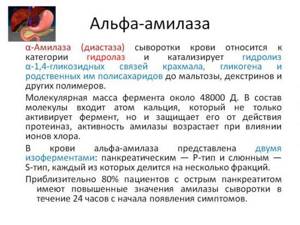
The duration of fasting before the study is 8–12 hours.
Prevention
To avoid changes in amylase levels, doctors recommend adhering to the following rules:
- Limit consumption of fatty foods.
- Eliminate foods high in coarse fiber from your diet.
- Do not drink instant coffee.
- Take vitamin complexes containing vitamins A, B1, B2, B12, C, P and folic acid.
- Stop smoking and drinking alcohol forever.
- Do not take medications without consulting your doctor.
- Avoid stress, take sedatives during high emotional stress.
- Treat infectious diseases in a timely manner.
- Play sports, do not neglect morning exercises.
- Get rid of excess weight.
- Normalize lipid metabolism.
- Use of hypoglycemic drugs.

To avoid changes in amylase levels, it is recommended, first of all, to exclude alcohol, coffee and strong tea, chocolate
Or help with a popular cryptocurrency (spoiler reveal):
BTC Address: 1Pi3a4c6sJPbfF2sSYR2noy61DMBkncSTQ ETH Address: 0x7d046a6eaa1bd712f7a6937b042e9eee4998f634 LTC Address: LUyT9HtGjtDyLDyEbLJZ8WZWGYUr537qbZ Yandex Money : 410013576807538 WebMoney (R is still working): R140551758553 and Z216149053852 ATOM Address (Cosmos): cosmos15v50ymp6n5dn73erkqtmq0u8adpl8d3ujv2e74 MEMO: 106442821 BAT Address: 0x7d0 46a6eaa1bd712f7a6937b042e9eee4998f634 BCH Address: 1Pi3a4c6sJPbfF2sSYR2noy61DMBkncSTQ BEAM Address: 24ec693cffe396c864e23971a40c7d0dffb1269395a9cbfef23b2 164245e06fb5e2 BNB Address : bnb136ns6lfw4zs5hg4n85vdthaad7hq5m4gtkgf23 MEMO: 106210477 BTT Address: TNcTQmrUFkfbVDJDuFjh5beeikJBX39ySm DASH Address: Xkey1QYD5r9kkh23iBDNW8z9pnTF9tmBuL DCR Address: DsnSzfzbe6WqNb581muMAMN7hPnzz8mZcdr DOGE Address: DENN2ncxBc6CcgY8SbcHGpAF87siBVq4tU ETC Address: 0x7d046a6eaa1bd712f7a6937b042e9eee4998f634 LINK Address: 0x7d04 6a6eaa1bd712f7a6937b042e9eee4998f634 MANA Address: 0x7d046a6eaa1bd712f7a6937b042e9eee4998f634 NANO Address: nano_17nn85ygnimr1djkx8nh7p8xw36ia69xoiqckb8quo57 ebweut1w8gu6gamm NEO Address: AS1XCr1MS1BA69DTxDkZW8yYpB9njPTWzG OMG Address: 0x7d046a6eaa1bd712f7a6937b042e9eee4998f634 ONT Address: AS1XCr1MS1BA69DTxDkZW8yYpB9njPTWzG P IVX Address: DBH7DfLaSxtdT4Gzno4gLMC3f5gcD6BGVe QTUM Address: QP9LDRoEXDfAzMZroS9nnB7gyTyRYjaUgu RVN Address: RKFTtbQ4jWEY9gwHodiH92utCc8iBzStaM STEEM Address: deepcrypto8 MEMO: 106757068 TOMO Address: 0x7d046a6eaa1bd712f7a6937b042e9eee4998f634 TRX Address: TNcTQmrUFkfbVDJDuFjh5beeikJBX39ySm TUSD Address: 0x7d046a6eaa1bd712f7a6937b042e9eee4998f 634 USDT (ERC-20) Address: 0x7d046a6eaa1bd712f7a6937b042e9eee4998f634 VET Address: 0x7d046a6eaa1bd712f7a6937b042e9eee4998f634 WAVES Address: 3PHUH2hAzhbRqnrJ8 tr9GFgnkkxLL15Rhpw XEM Address: NC64UFOWRO6AVMWFV2BFX2NT6W2GURK2EOX6FFMZ MEMO: 101237663XMR: 83QPpH5bSKXDudRyPtNuMJFxcpXJ7EKMQNerFJsmYBRic1cq5t6doSF5okYmsEM9YTUDheqEsLeyh94GzUTsxkKM 35fRAyj XRP Address: rEb8TK3gBgk5auZkwc6sHnwrGVJH8DuaLh XRP Deposit Tag: 105314946 XTZ Address: tz1Q5YqkEZSwqU97HrC8FipJhSXcEyB3YGCt XVG Address: DDGcaATb3BWNnuCXbTZMf6fx 9Cqf2v1PWF ZEC Address: t1RBHUCbSWcDxzqeMCSPYdocKJuNGZvVJHn
How to normalize an indicator
Alpha amylase is elevated in the blood: the causes of this condition can be eliminated with the help of medications. Among the special drugs there are Kontrikal and Gordox. Contrical is a polypeptide obtained from the lung tissue of cattle. The substance disables the kallikrein-kinin system. Reduces the overall proteolytic activity of enzymes.
Available in the form of a lyophilisate for mixing a solution for intravenous administration. 1 package contains 10 bottles with lyophilisate and 10 ampoules with solvent.
Gordox is a drug based on aprotinin. The substance also inhibits proteolytic activity. Leads to the formation of reversible stoichiometric complexes to block the activity of tissue and plasma kallikrein, plasmin and trypsin.
It is used in surgical practice to reduce blood loss and the need for blood transfusion. 1 ampoule contains 100,000 KIU of aprotinin. Available in packs of 5 or 25 pcs.
If there is no access to professional help for the administration of drugs, you can limit yourself to taking digestive enzymes based on pancreatin - Mezim, Creon and others. Compensating the activity of the pancreas will give it the opportunity to recover independently. The medications are taken strictly with meals.
During the course of treatment, regular monitoring of blood dynamics will be required. The frequency of collection of biomaterials will be determined by a gastroenterologist after treatment. And the most important rule is complete abstinence from drinking alcohol. Ethanol is a powerful toxic agent for the pancreas.
The strongest negative effects are observed when consumed on an empty stomach, in large volumes and on a regular basis. During acute pancreatitis, the pain is very intense, and eating food causes even greater severity. For initial relief of the patient’s condition, it is permissible to take enzymes regardless of food intake.
After the onset of relief, you should gradually begin to eat light foods without fiber and fat: porridge, fermented milk products and grated cottage cheese, lean meat or boiled chicken. Then you can introduce regular white bread. And be sure to continue taking enzymes. A smooth approach will allow you to quickly relieve the exacerbation and restore the functions of the pancreas to its full extent.
Level up
The most pronounced increase in the level of alpha-amylase in the blood occurs in acute pancreatitis: the activity of the enzyme increases 6–10 times. A sharp change in indicators occurs in the interval from 2 to 12 hours after damage to pancreatic tissue and persists for several days. In acute pain caused by pancreatitis, test results usually exceed 1000 U/l, but in some cases they may be within the reference values. In the chronic course of the disease, amylase activity first increases moderately, and then, as pancreatic cells die, decreases, reaching a normal level.
Also, a sharp and pronounced increase in the amount of amylase in the blood occurs in acute conditions: abdominal trauma with damage to the digestive tract and/or pancreas, perforation of a stomach ulcer, intestinal obstruction, acute appendicitis, peritonitis. A moderate increase in enzyme activity is determined in the presence of an inflammatory process in the pancreas and nearby organs. The release of the enzyme from the cells occurs due to a local increase in temperature and increased blood circulation. Changes of this nature are observed in chronic appendicitis, typhoid fever, cholecystitis, ectopic pregnancy (without rupture of the tube), and the initial stages of pancreatic cancer. The reasons for a slight or moderate increase in the concentration of alpha-amylase in the blood may be: renal failure, mumps, viral hepatitis, sarcoidosis, alcoholism, macroamylase, diabetic ketoacidosis.
Prevention of amylase elevations
Prevention of pathologies associated with increased amylase involves proper lifestyle and diet. It is necessary to exclude spicy, fatty and fried foods, baked goods, coffee and alcohol from the diet. The menu should consist of cereal dishes, fruits and vegetables (with the exception of onions, garlic, radishes and sorrel), and boiled lean meat.
Food should be boiled, baked without oil or cooked in a slow cooker, and eaten in small portions - at least four to five times a day, in small portions. The basic principle of nutrition when amylase levels are elevated is to avoid prolonged hunger, but not to overeat. In addition, it is recommended to quit smoking, reduce stress if possible and engage in light physical activity.
If you are prone to disorders of the digestive tract and other organs, during which disruptions in the production of enzymes occur, you need to regularly undergo preventive examinations with a doctor and take tests.
Diet for amylase level disorders
An increase and decrease in the enzyme is mainly provoked by various diseases of the digestive system. A specific case requires an individual therapeutic program. Common to all diseases is the requirement to adhere to a certain diet.
Advice! Nutrition should be gentle, but not limited. Indeed, some foods will have to be eliminated or their consumption reduced. But the list of what is allowed is quite extensive.
There are certain rules, following which you can easily organize optimal nutrition. It will enhance the effect of drug therapy:
- Preference should be given to cooking methods such as baking, stewing, and boiling.
- It is better to use meat obtained from young animals. Also, these should be non-fat varieties. The same rule applies to fish.
- It is necessary to completely exclude smoked meats, kidneys, and brains.
- When cooking, the amount of fat should be minimal, or better not use it at all.
- When consuming fresh fruits, it is recommended to cut off the peel. White cabbage is undesirable among vegetables, especially fresh.
- Food should not be excessively hot or, on the contrary, very cold.
- It is best to choose bread from grade I or II flour. It is necessary to limit fresh baked goods made from butter or puff pastry.
- Spices and vegetables, which irritate the mucous membranes of the digestive system, are completely excluded from the diet.
Soups should have a slimy consistency. You can also prepare pureed soups with milk, vegetable or meat (low-fat but strong) broth.
It is also possible to prepare main courses from cereals, with the exception of millet - porridges, puddings, casseroles. They can be supplemented with stewed or boiled vegetables.
